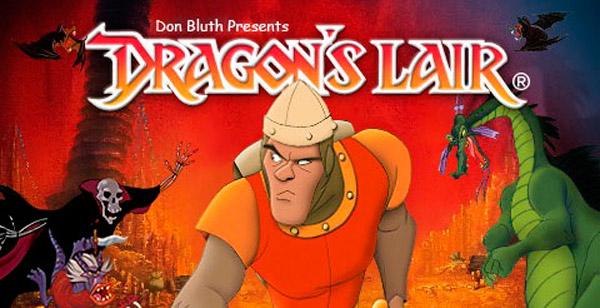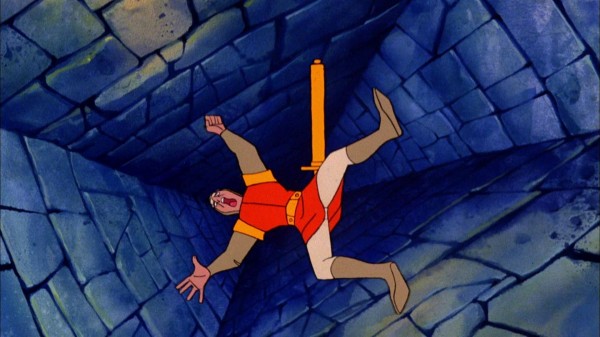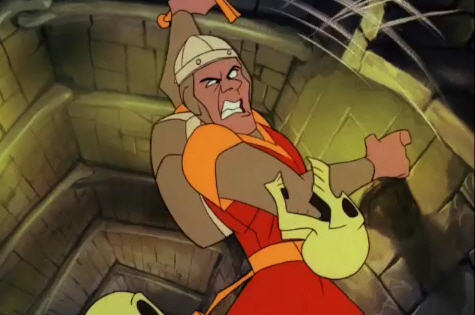Dragon’s Lair review (XBLA)
Dragon’s Lair was developed by Digital Leisure and published by Microsoft Studios. It released May 18, 2012 for 800 MSP. A copy was provided for review purposes.
Odds are, you’ve played Dragon’s Lair – or, at least, know the basic style and premise well enough. Since its release in the early 1980s, Don Bluth’s magnum opus has been released and rereleased literally dozens of times on as many platforms. The game puts the player in the shoes of Dirk the Daring, a knight who ventures into the lair of the evil wizard Mordroc to rescue Princess Daphne from the nefarious dragon Singe. Rather than controlling Dirk directly, the player controls his reflexes at periodic intervals as he traverses through the castle – think quick time events – and slow reaction time or choosing the wrong action at the wrong time spells certain doom for the hero.
Until last week, the Xbox 360 was one of the few systems the game hadn’t been ported to. How does Digital Leisure – no stranger to repurposing the game for new platforms – do with the transition? About as well as can be expected…but that may not be a good thing.
Here’s what we liked:
It’s like playing a cartoon – Undoubtedly, Dragon’s Lair has persisted in popularity because of its unique visual style (at least, a style that was more unique and revelatory when it first debuted). That’s a fair bit of praise, as the animation – by Don Bluth, of An American Tail and The Land Before Time fame – is absolutely gorgeous and holds up to this day. It is literally like playing through a cartoon and, considering the game first released in 1983 – two years before Super Mario Bros. took the world by storm – that is no small feat. Area and character designs are legitimately creative and colorful, making them a joy to take in.
Sense of humor – When the controls aren’t frustrating you, Dragon’s Lair can be pretty funny in an early-90’s-animated-movie kind of way. Dirk the Daring amuses as he bumbles through the castle and the death scenes will elicit a chuckle or two (the first few times you see them, anyway). It’s not going to replace your favorite comedy next time you need a pick-me-up, but it’s a far cry from the grim-n-gritty of bigger console titles like Gears of War or Call of Duty.
Here’s what we didn’t like:
Controller malfunction – Though it’s listed as an Arcade Kinect title, that little piece of hardware isn’t required to play Dragon’s Lair; it’s fully playable with a normal controller. That said, those controls can be touchy and unpredictable. Dragon’s Lair is, to a point, about precision and speed, but there are times when it feels as though the game is just out to get you. No matter how well you time that leap or sword swing, you still end up missing quite a few prompts. Granted, a certain amount of success in Dragon’s Lair lies in memorizing patterns and inputting them correctly, but there are times when it seems as though the controller conspires to keep you from successfully running through the right sequence on a consistent basis (We’re willing to admit a certain amount of user error may contribute to this, but it happened too consistently during our playthroughs for these problems to be fully attributed to that).
You are the (broken) controller – Kinect fares a little better, but it’s all over the place in terms of difficulty. Playing with the Kinect on Easy requires so little of the player, they can literally stand and do nothing as Dirk tracks down and defeats Singe single-handedly (trust us, we tried – the only ill affect the player sees is that the game registers the player making the “right move” just a little too late and a penalty when it comes to points). Playing on the harder difficulty requires more precision than the game is apparently willing to recognize – expect a lot of missed sword swipes and jumps you’re sure you nailed. This might be forgivable if there were a range of difficulties that challenged your reaction speed, but there aren’t – there’s just “Easy” and “Hard.” If you’re playing on “Easy,” you don’t need to do a thing; on “Hard” it feels like nothing you do is right. There seems to be little to no middle ground.
Intuition (or, lack thereof) – So you’re trekking along, making fine progress on your way to save the princess. Suddenly, a giant spider attacks! What should you do? Probably attack it with your sword, right? Oh, sorry – you were supposed to jump to the left and THEN start swinging. Situations pop up like this with some regularity in Dragon’s Lair – a situation arises and the course of action that seems most logical is not the one the game wants you to take (and there’s no room for error). This can lead to a lot of cheap deaths (the only kind Dragon’s Lair deals in, really) and more than a little frustration. That frustration is mitigated somewhat by the option to activate on-screen prompts which tell you what action to take – even so, the iffy controls still mean you’re going have plenty of cheap deaths ahead of you.
Like looking into a mirror – How did you feel about the room where you had to face off against the Black Knight? Hopefully it didn’t give you too much trouble, because you’re going to have to play it again. Dragon’s Lair has this habit of throwing the Dirk into rooms that are exactly same as areas he’s previously traversed, only reverse (if you jumped left, then right the first time you fight the Black Knight, the second time around you’ll jump right, then left). Not every area is recycled, but enough of them are that it gets old real fast. It artificially pads the length of the game and feels downright lazy.
Astute readers may notice few of these complaints have anything to do with Digital Leisure’s port of the game – and, to be fair, that’s true. Digital Leisure translated the game more or less faithfully from its original incarnation…but, dare we say, that original incarnation isn’t very good to begin with. With all the interactivity of a DVD menu screen, it can hardly be classified as a “game” at all (heck, the game has literally even been ported to home DVD players). The player is merely required to push the button at the right time – it is, to put it simply, a game made of nothing but quick time events. This is, to put it bluntly, not fun or interesting. The novelty of the visual style wears off fairly quickly, leaving the player with little else to actually enjoy about the game. There are better ways to spend your 800 MSP and there are certainly better classics on XBLA more deserving of your time and attention.
Score: Skip It





